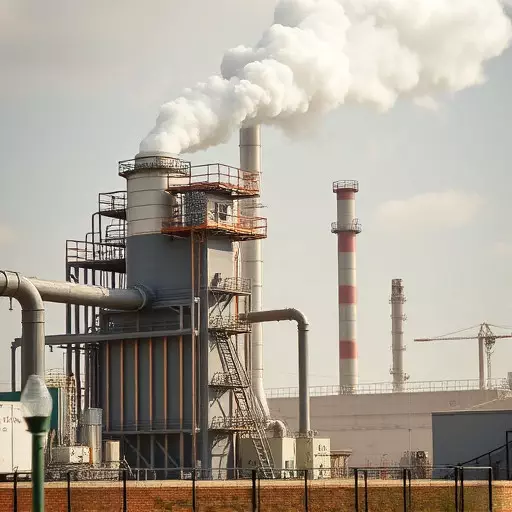Electrostatic precipitators (ESPs) are advanced air quality solutions that capture and remove particulate matter from industrial emissions using electrostatic forces. They handle high volumes of gas and particulate matter, including fine particles, making them ideal for dust collection in ventilation systems, emission control from boilers and exhaust fans, and maintaining environmental standards in industries like manufacturing, power generation, and mining. ESPs offer cost-effective, efficient, and versatile emission control technologies, contributing to cleaner air and sustainable industrial practices.
“Electrostatic precipitators (ESPs) are advanced air quality solutions that play a pivotal role in tackling industrial emissions. This comprehensive guide explores ESP technology and its diverse applications. We delve into the science behind electrostatic precipitation as a powerful dust collection method, offering significant advantages for emission control. From understanding the operating principles to examining various types, this article provides an insightful overview. Discover how ESPs are transforming industrial sites, ensuring cleaner air through innovative dust collection solutions.”
- Understanding Electrostatic Precipitators: A Comprehensive Overview
- Air Quality Solutions for Industrial Sites: The Role of ESPs (Electrostatic Precipitators)
- Dust Collection Solutions: How Electrostatic Precipitation Works
- Emission Control Technologies: Benefits and Applications of ESPs
- Operating Principles: Electric Fields, Particles, and Their Interaction
- Types of Electrostatic Precipitators: Design Variations for Different Needs
- Case Studies: Real-World Success Stories of Electrostatic Precipicator Implementation
Understanding Electrostatic Precipitators: A Comprehensive Overview
Electrostatic precipitators (ESPs) are advanced air quality solutions designed to capture and remove particulate matter from industrial emissions, offering a powerful tool in the fight against air pollution. These devices use electrostatic forces to charge particles, allowing them to be attracted to and collected on electrically charged plates or collectors. ESPs are particularly effective for dust collection solutions, making them indispensable in industries like manufacturing, power generation, and mining, where controlling and minimizing emissions is of utmost importance.
As emission control technologies go, ESPs provide a cost-effective and efficient method to improve air quality around industrial sites. They can handle high volumes of gas and particulate matter, ensuring that even the finest particles are captured. This makes them ideal for various applications, from removing dust and smoke from ventilation systems to controlling emissions from boilers and exhaust fans. With their ability to significantly enhance air quality, ESPs play a crucial role in maintaining environmental standards and fostering sustainable industrial practices.
Air Quality Solutions for Industrial Sites: The Role of ESPs (Electrostatic Precipitators)
Electrostatic precipitators (ESPs) play a pivotal role in providing effective air quality solutions for industrial sites. These advanced dust collection solutions are specifically designed to control and reduce emissions from various industrial processes, ensuring cleaner air for both workers and surrounding communities. ESPs operate by using an electrostatic charge to attract and capture fine particles, including dust, smoke, and aerosols, from exhaust gases. This technology is particularly crucial in industries like manufacturing, power generation, and mining, where high-emissive sources require stringent emission control technologies.
By employing ESPs as part of a comprehensive dust collection system, industrial facilities can significantly minimize the release of hazardous particulate matter into the environment. These emission control technologies not only enhance air quality but also contribute to the overall sustainability and responsibility of industrial operations. Moreover, ESPs offer advantages such as high efficiency, low maintenance requirements, and the ability to handle a wide range of particle sizes, making them indispensable in the pursuit of cleaner and healthier industrial environments.
Dust Collection Solutions: How Electrostatic Precipitation Works
Electrostatic precipitators are a powerful tool in the quest for improved air quality solutions for industrial sites. They offer an effective dust collection solution, playing a significant role in emission control technologies. The process begins when particles of dust or other pollutants are charged by a high-voltage electric field. This charge causes them to adhere to oppositely charged collector plates, effectively removing them from the air stream.
This technology ensures that industrial processes produce less pollution by capturing and filtering out fine particles before they escape into the atmosphere. By employing electrostatic precipitation as a dust collection solution, industries can contribute to cleaner air, meeting environmental standards while maintaining efficient operations.
Emission Control Technologies: Benefits and Applications of ESPs
Electrostatic Precipitators (ESPs) are powerful emission control technologies that play a pivotal role in enhancing air quality solutions for industrial sites. By utilizing electrostatic forces, ESPs efficiently capture and remove fine particles, such as dust and smoke, from exhaust gases. This process not only improves the overall air quality but also ensures compliance with stringent environmental regulations. One of the primary advantages of ESPs is their ability to provide effective dust collection solutions, making them an indispensable tool for industries like manufacturing, power generation, and mining, where high-intensity operations can lead to significant particulate emissions.
The benefits of ESPs extend beyond mere emission reduction. They offer a cost-effective and reliable method for achieving high levels of air pollution control, particularly in applications where other technologies may struggle. For instance, in harsh environments or when dealing with highly reactive substances, ESPs demonstrate their versatility by successfully managing emissions from diverse industrial processes. As a result, they have become an integral part of the arsenal for any organization seeking innovative dust collection solutions and striving to meet its environmental stewardship goals.
Operating Principles: Electric Fields, Particles, and Their Interaction
Electrostatic precipitators operate on the principle of using electric fields to attract and capture particles, primarily dust and particulate matter, from the air. The process involves applying a high voltage difference between a collection plate (often called a collector) and an electron-emitting grid, typically made of metal wires. When air flows through this field, charged particles in the air are either attracted to the collector or repelled by it, depending on their charge. This phenomenon is at the core of electrostatic precipitation as a powerful air quality solution for industrial sites.
In this setup, neutral particles become charged upon encountering the grid, acquiring a positive or negative charge. Similarly, dust and other small particles in the air are also ionized due to friction with air molecules. These charged particles then travel towards either the collector (for positively charged particles) or an oppositely charged ground (for negatively charged ones). This interaction effectively filters the air stream, resulting in clean air exiting the precipitator and leaving behind collected dust as a by-product. As a result, electrostatic precipitators are among the most efficient dust collection solutions and emission control technologies available, playing a significant role in maintaining air quality in industrial settings.
Types of Electrostatic Precipitators: Design Variations for Different Needs
Electrostatic precipitators come in various designs, each tailored to meet specific needs in air quality management, particularly at industrial sites. One prominent category is the dry electrostatic precipitator, efficient for removing fine particles like dust and ash from exhaust gases. These units operate by charging particles, attracting them to collection plates, and then shedding them periodically.
Another type is the wet electrostatic precipitator, suitable for handling more challenging pollutants that can form complex compounds. This design incorporates water spray or mist to prevent particle agglomeration, enhancing their electric charge and facilitating easier removal. Wet EP systems are often preferred for emission control technologies in industries where high-level pollution control is required, such as in the metal processing and chemical manufacturing sectors, offering effective dust collection solutions.
Case Studies: Real-World Success Stories of Electrostatic Precipicator Implementation
Electrostatic precipitators (ESPs) have proven to be game-changers in many industries, offering effective air quality solutions for industrial sites. Real-world success stories showcase their ability to mitigate dust collection challenges and control emissions from a variety of processes. For instance, in the manufacturing sector, ESPs have been deployed to capture fine particulate matter generated during metal processing, significantly improving workplace safety and reducing environmental impact. These advanced dust collection solutions not only enhance air quality but also comply with stringent emission standards.
Another notable application involves power generation facilities where ESPs play a crucial role in controlling emissions from coal-fired boilers. By efficiently removing fly ash and other pollutants, these emission control technologies contribute to cleaner, more sustainable operations. Case studies demonstrate that the successful implementation of ESPs has led to notable reductions in particulate matter emissions, reflecting their value as a clean air solution for industrial settings.


